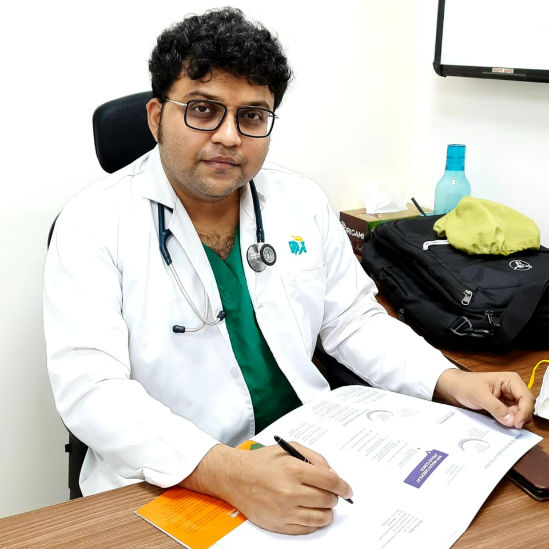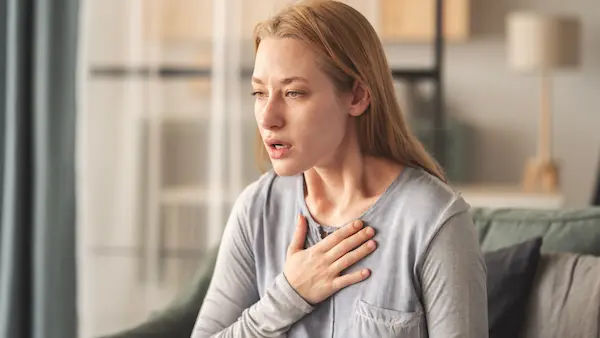Bhastrika Pranayama Benefits, Steps, and Health Advantages
Learn bhastrika pranayama benefits, safe steps, and tips. Evidence-based yoga breathing to boost energy, reduce stress, and support well-being.

Written by Dr. Siri Nallapu
Reviewed by Dr. D Bhanu Prakash MBBS, AFIH, Advanced certificate in critical care medicine, Fellowship in critical care medicine
Last updated on 17th Nov, 2025

Introduction
Breathing is one of the simplest tools we have to shift how we feel—more calm, more alert, and more focused. Bhastrika pranayama (often called “bellows breath”) is a traditional yoga breathing technique that uses active, rhythmic inhales and exhales to energise the body. People often ask about bhastrika pranayama benefits because they’re looking for natural ways to manage stress, improve breath control, and support overall wellness. While research on specific pranayama styles is growing, large health organisations agree that mindful breathing can help reduce stress and support mental well-being. If you’re curious about yoga breathing, this guide explains what bhastrika is, how to practise it safely, and what health advantages it may offer.
What Is Bhastrika Pranayama?
Bhastrika is a dynamic form of pranayama (yogic breathwork) that involves forceful, equal-length inhales and exhales through the nose, powered by the diaphragm and abdominal muscles. It is traditionally practised in seated postures with an upright spine.
Key Points:
- “Bellows” action: The abdomen moves actively as you inhale and exhale, like a bellows fanning a flame.
- Pace: Short, brisk, and even breaths. Beginners should start slower and shorter, then build up gradually.
- Focus: Mouth stays closed; breathing is through the nose.
- After each round: Rest with relaxed, natural breathing before repeating.
Bhastrika is considered stimulating during the active breathing, followed by a settling, clearer feeling during rest. Some advanced traditions include breath retention, but beginners should practise without retention, and anyone with medical concerns should check with a healthcare professional first.
Bhastrika Pranayama Benefits
People practise bhastrika for energy and clarity, but what does the science say? While rigorous research on this exact technique is still limited, high-quality medical sources support the broader benefits of controlled breathing for stress relief, autonomic nervous system balance, and mental focus. Early studies on pranayama as a whole suggest potential benefits for cardiovascular and respiratory function.
Possible Benefits:
- Short-term boost in alertness and focus: Fast, rhythmic breathing can temporarily increase energy and sharpen attention, especially when followed by a calm rest period.
- Stress management support: Breath control is a cornerstone of many relaxation programmes. Practising bhastrika in a structured way—and finishing with slower, calming breaths—may help you feel less tense.
- Better breath awareness and respiratory muscle training: Active inhalation and exhalation can strengthen diaphragmatic control and improve awareness of breathing patterns.
- Potential cardiovascular benefits when practised safely: Regular, mindful breathing practices have been linked to improved heart rate variability and modest reductions in perceived stress. Some studies on pranayama report improvements in blood pressure and general well-being.
- Nasal airway conditioning: Nose breathing helps warm, humidify, and filter air, which can feel more comfortable than mouth breathing for many people.
Important Note: Bhastrika is activating and can feel intense. If you are new to yoga breathing, start gently and consult your clinician if you have medical conditions. It is not a treatment for health problems and does not replace medical care.
What Science Says About Yoga Breathing?
- Controlled breathing (including diaphragmatic and slow breathing techniques) is recommended by major health organisations as a simple tool for stress management.
- Clinical resources from Harvard Health Publishing, the Mayo Clinic, and the Cleveland Clinic describe how breath exercises can help calm the stress response, improve focus, and support overall well-being.
- Research on pranayama suggests potential improvements in anxiety, sleep quality, and blood pressure for some people. Evidence varies by technique; more high-quality studies are needed for bhastrika specifically.
How to Practise Bhastrika Pranayama: Step-by-Step
Before You Start:
- Choose a quiet place. Sit comfortably with an upright spine (on a chair or on the floor).
- Practise on an empty or light stomach (ideally 2–3 hours after a meal).
- If you feel dizzy or uncomfortable at any point, stop and breathe normally.
Consult Top Specialists
Step-By-Step (Beginner-Friendly, No Breath Retention)
Here’s a step-by-step guide to do bhastrika pranayama:
Set Your Posture
Sit tall with relaxed shoulders and a long neck. Place your hands on your thighs or belly to feel the movement.
Warm Up with 3–5 Easy Breaths
Inhale through the nose gently, exhale gently. Let the belly move naturally.
Start the Bhastrika Rhythm
Inhale through the nose using the diaphragm so the belly expands.
Exhale through the nose, actively engaging the abdominal muscles to press air out.
Keep the inhales and exhales strong but controlled, and about equal in length.
Find a Safe Pace
Beginners: 10–15 brisk breaths per round (about one breath per second or slower).
After the round, rest and breathe normally for 30–60 seconds.
Repeat Rounds
Do 2–3 rounds total. As you gain experience, you can gradually increase each round to 20–30 breaths, staying within comfort.
- Cool Down
Finish with 1–2 minutes of slow, gentle belly breathing to settle your system.
Tips for Beginners
- Start slower than you think. The goal is steady, even inhales and exhales—not speed.
- Keep your face, jaw, and shoulders relaxed.
- If you feel light-headed, slow down or stop and breathe normally.
- Do not add breath holds (retentions) until you are experienced and have medical clearance if you have any health issues.
Safety, Risks, and Who Should Avoid or Modify
Bhastrika is more vigorous than many other breath techniques. You should consult a healthcare professional before practising if you have:
- Uncontrolled or severe high blood pressure, cardiovascular disease, or a history of stroke
- Respiratory conditions (such as asthma or COPD); some may tolerate bhastrika poorly—get personalised advice
- Anxiety disorders or panic disorder (fast breathing may trigger symptoms)
- Pregnancy or have recently given birth
- Eye conditions such as glaucoma
- Recent surgery, hernia, or gastrointestinal concerns where increased abdominal pressure is a risk
- Epilepsy, significant vertigo, or frequent migraines
Stop the Practice If You Experience:
- Dizziness, tingling, chest pain, palpitations, visual changes, or strong discomfort
- Anxiety, panic, or a sense of breathlessness that doesn’t ease with rest
General Safety Guidelines:
- Keep sessions short (a few minutes) and end with slow breathing.
- Practise in a stable, seated position.
- Avoid practising when extremely tired, dehydrated, or overheated.
- Do not force the breath.
How Bhastrika Compares to Other Yoga Breathing Techniques?
Here’s how bhastrika compares to other yoga techniques:
- Bhastrika (Bellows Breath): Fast, active inhales and exhales; energising; best for short, focused sessions with a calming cool-down.
- Diaphragmatic (Belly) Breathing: Slow, gentle breaths emphasising the diaphragm; calming and often used for relaxation and stress reduction.
- Alternate Nostril Breathing (Nadi Shodhana): Slow, controlled breathing through one nostril at a time; commonly used to promote balance and calm.
- Box Breathing (Equal Inhale, Hold, Exhale, Hold): A structured slow-breathing pattern used for focus and calm; generally more suitable for beginners than bhastrika.
When to Use Which:
- Need energy or alertness? Short bhastrika rounds can help.
- Need calm or stress relief? Choose diaphragmatic breathing or alternate nostril breathing, or follow bhastrika with several minutes of slow breathing.
How Often Should You Practise?
- For beginners: 2–3 rounds of 10–15 breaths, 3–4 days per week.
- Gradually increase to 2–3 rounds of 20–30 breaths as tolerated.
- Always end with 1–2 minutes of slow, gentle breathing.
- Consistency matters more than intensity. Keep sessions short and comfortable.
Common Mistakes and How to Fix Them
- Going too fast, too soon: Slow your pace; make breaths strong but steady.
- Chest-only breathing: Place a hand on your belly to guide diaphragmatic movement.
- Tension in the face and shoulders: Relax your jaw and drop your shoulders.
- Skipping rest periods: Take 30–60 seconds of normal breathing between rounds.
- Practising when unwell or after a large meal: Wait until you feel well and practise on an empty or light stomach.
Consult Top Specialists
Conclusion
Bhastrika can be a powerful addition to your wellness routine when practiced with care. If you’re new to yoga breathing, focus first on gentle, slow techniques and add short bhastrika rounds when you feel ready. Build gradually, stay mindful of how your body responds, and seek guidance from a qualified instructor or healthcare professional if you have medical conditions. With safe, consistent practice, you can explore the energizing side of breathwork while supporting overall well-being.
Consult Top Specialists

Dr. Anand Misra
General Physician/ Internal Medicine Specialist
14 Years • MBBS, DNB
Mumbai
Apollo Hospitals CBD Belapur, Mumbai

Dr. Aakash Garg
Gastroenterology/gi Medicine Specialist
12 Years • MBBS, DNB (Medicine), DrNB (Gastroentrology).
Bilaspur
Apollo Hospitals Seepat Road, Bilaspur
(150+ Patients)

Dr. Thirupathy K S
General Physician/ Internal Medicine Specialist
11 Years • MD
Karaikudi
Apollo Hospitals Karaikudi, Karaikudi
(75+ Patients)

Dr. Ahmad Ather Ali
General Physician/ Internal Medicine Specialist
4 Years • MBBS
Manikonda Jagir
Apollo Clinic, Manikonda, Manikonda Jagir
(25+ Patients)

Dr. Utsa Basu
Diabetologist
14 Years • MBBS, MD
Kolkata
Dr Utsa Basu Clinic, Kolkata
(400+ Patients)
Consult Top Specialists

Dr. Anand Misra
General Physician/ Internal Medicine Specialist
14 Years • MBBS, DNB
Mumbai
Apollo Hospitals CBD Belapur, Mumbai

Dr. Aakash Garg
Gastroenterology/gi Medicine Specialist
12 Years • MBBS, DNB (Medicine), DrNB (Gastroentrology).
Bilaspur
Apollo Hospitals Seepat Road, Bilaspur
(150+ Patients)

Dr. Thirupathy K S
General Physician/ Internal Medicine Specialist
11 Years • MD
Karaikudi
Apollo Hospitals Karaikudi, Karaikudi
(75+ Patients)

Dr. Ahmad Ather Ali
General Physician/ Internal Medicine Specialist
4 Years • MBBS
Manikonda Jagir
Apollo Clinic, Manikonda, Manikonda Jagir
(25+ Patients)

Dr. Utsa Basu
Diabetologist
14 Years • MBBS, MD
Kolkata
Dr Utsa Basu Clinic, Kolkata
(400+ Patients)
More articles from General Medical Consultation
Frequently Asked Questions
1) What are the main bhastrika pranayama benefits?
Bhastrika may boost alertness, support stress management, and improve awareness of diaphragmatic breathing. Like other yoga breathing practices, it can help you feel more in control of your breath and focus. It is not a medical treatment and should be practiced safely.
2) Is bhastrika safe for beginners?
Yes, if you keep it gentle, short, and skip breath retention. Start with 10–15 breaths per round, rest afterward, and stop if you feel dizzy or uncomfortable. People with health conditions should check with a clinician first.
3) Can bhastrika lower blood pressure?
Breathing exercises are commonly recommended for stress management, and some pranayama research suggests potential blood pressure benefits. However, bhastrika is stimulating; pair it with slower breathing afterward. If you have high blood pressure, get medical advice before trying it.
4) How is bhastrika different from kapalabhati?
Both are active techniques, but kapalabhati emphasizes passive inhales and forceful exhales, while bhastrika uses forceful, active inhales and exhales of roughly equal length. Bhastrika typically feels more vigorous overall.
5) When is the best time to practice?
Morning or early in the day, on an empty or light stomach, is common. Avoid practicing right after meals or before bedtime if it makes you feel energized.


.webp)
.webp)
